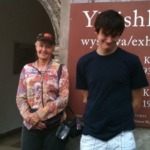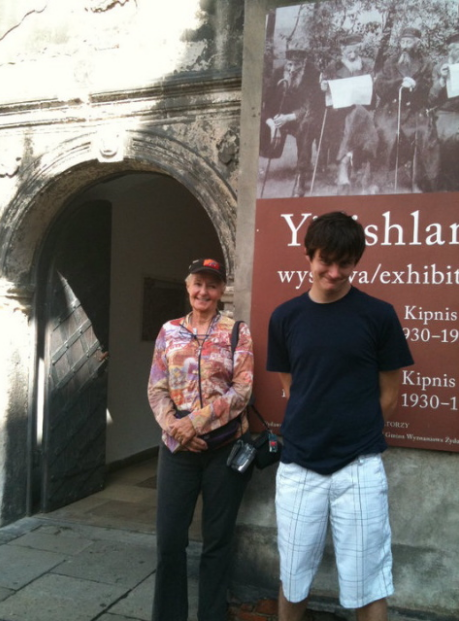Springtime for Poland
 Poland may not be the first country you think of to visit in Europe, but with its history and culture, it can hold its own against any destination.
Poland may not be the first country you think of to visit in Europe, but with its history and culture, it can hold its own against any destination.
Poland may not be the first country you think of to visit in Europe, having to compete as it does with more glamorous places like Italy and France. But on a recent trip, I discovered a fascinating place whose history has several times changed the history of our world.
My daughter, author and journalist Danielle Crittenden Frum, has written a Polish cookbook with Pulitzer Prize-winning author Anne Applebaum, who is married to Poland's foreign minister. So I escorted two young grandchildren to Warsaw to join the family group for one week, while Danielle organized photos for the book.
The capital city was 80% leveled by the Nazis in World War II but has been reconstructed to the last detail -- although it takes away from the historic atmosphere to realize that churches and buildings are mostly only a few decades old.
A main point of interest is the Uprising Museum commemorating the 1944 rebellion when the Polish home army rose up against Nazi occupation before the Soviet entry into the city. It ended tragically when the Soviets halted their charge until the Germans had brutally suppressed the insurrection. Poland wanted to liberate itself and owe its freedom to no one. The Soviet troops sat waiting and watching across the Vistula river.
Then there's the small but deadly Gestapo museum, where the Nazis tortured their prisoners to gain information. Its tiny cells, instruments of torture and an eerie phantom figure writhing against a wall, plus videos telling the stories of inmates, make it unforgettable.
On a less gruesome note, Livitsky Park has a wonderful canopied restaurant, The Belvedere, in the middle of an orangerie near the 18th-century Palace of Poland's last King. Here one can have a delicious (but expensive) meal and watch peacocks strut by. Composer Frederic Chopin was, of course, Poland's great musical genius and one can listen to outdoor concerts of his works and even visit his heart, which rests in Three Crosses Church (he is buried in Paris's Pere Lachaise cemetery).
It's a 2.5-hour train ride to Cracow. The beautifully preserved baroque city, which dates back to the 13th century, was Nazi Headquarters during the Second World War. Cracow was Poland's capital until 1795 when the last Polish king moved to Warsaw. We stayed at the tiny elegant Copernicus hotel, located on Cracow's oldest street in the shadow of Wawel castle, home of Polish kings for 300 years. The historic hotel was once a home, which was visited by the great Polish astronomer several times. Copernicus established mathematically that the world revolved around the sun, predating the more famous Galileo.
During the war, the castle was taken over by the Nazi occupation government. Visitors can tour both state and private rooms, filled with paintings and some original furniture but its true glories are magnificent tapestries, among the finest in Europe. (A plaque indicates they were stored in Canada for the duration of the war.)
Polish cuisine is surprisingly good. Apart from the ubiquitous piroghis, which are delicious and cheap, there are warm, earthy foods with exotic flavors -- rye-based soups such as Zurek, chicken cooked like wiener schnitzel and fabulous desserts.
Like in all East European countries, amber jewelry is everywhere, cheap and varied. One can buy a handsome silver and amber ring, for example, for about $40.
Cracow is filled with beautiful churches, almost all Catholic, the main religion. The old Jewish quarter has seven synagogues dating to the 16th century. One is active fulltime, another part-time and the rest closed or used as museums. It's heartening to see a Jewish neighborhood in Poland still lively with cafes, markets and tourists.
A newly opened attraction is the Oskar Schindler museum, located in the famous factory of the man who saved so many Jewish employees from the death camps. It's in an industrial area outside Cracow and is filled with memorabilia, including a circular room engraved with the names of those on the historic "List."
Visitors to Cracow can take two interesting but very different side trips. First there is the Wieliczka Salt Mine, one of the oldest mines in Europe and a World Heritage site. Its unique galleries, chapels, statues and chambers were carved out of the saltbed by workers over the centuries. Be warned, however, that there are 378 steps down to the first level and a 2.5-km walk in the mine (an elevator, however, whisks you to the top).
But the most compelling trip is to the notorious Nazi death camps -- Auschwitz and Birkenau. A 90-minute train or bus ride from Cracow, Auschwitz is now a state-run museum. (Arrive before 10 a.m. or after 3 p.m. to avoid the expensive and crowded guided tours.)
Auschwitz began as a Nazi work camp to house Poles. But from 1942 on, it became clear to the Germans that eradicating Jews was too slow when carried out by normal execution methods. So Auschwitz was turned into Europe's largest center for the mass murder of Jews (and others). Millions were gassed, then burned in the ovens.
Like other Holocaust museums, Auschwitz contains masses of dusty suitcases, huge stacks of hair, trinkets and other artifacts belonging to the victims.
Later, another camp was built specifically for executions in nearby Birkenau. This one is even more ominous than Auschwitz as it's been left virtually untouched. There are solid brick barracks on one side of the rails (for those selected as workers) and the ruins of gas chambers on the other (destroyed by the Nazis as Allied troops approached). Both sides are surrounded by electrified fences and wooden guard watch towers.
Birkenau seemed more moving and solemn than Auschwitz, which has the outward appearance of civilization. Birkenau was the literal end of the line for millions of people, and a single boxcar remains on the track as a mute symbol of those who met their end there.
At the end of the tracks is a huge stone memorial to Holocaust victims. We saw myriad groups of Israeli Jews, young and old, shoulders draped with large blue and white flags, who crowded both camps and marched along as if to say to the world -- you tried to exterminate us but you didn't and here we still are.
Even non-Jews were moved to tears as one group sang the Hatikvah, the Israeli anthem which means “The Hope.”
 The author and her grandson Nat in front of an old synagogue in the Jewish quarter of Cracow. The site now houses a Jewish bookstore.
The author and her grandson Nat in front of an old synagogue in the Jewish quarter of Cracow. The site now houses a Jewish bookstore.
Tweet

